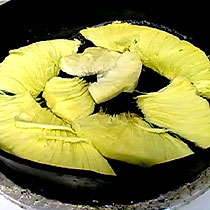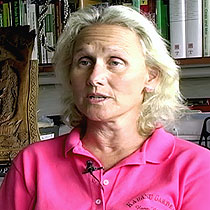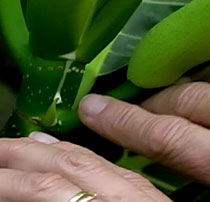2007年VOA标准英语-Breadfruit Advocates Say It Could Solve Hunger(在线收听)
By Zulima Palacio
Washington
28 June 2007
Breadfruit is widely cultivated in tropical regions of the world, especially in the Pacific. And yet, advocates say it is mostly ignored as a potential solution to hunger. They point out that breadfruit produces nutritious food comparable to rice, and a high yield of wood and other products.
Producer Zulima Palacio explores the subject. Barry Wood narrates.
 |
| Breadfruit |
Diane Ragone is with the Breadfruit Institute. She demonstrates her favorite way to cook it. "This is my favorite way to eat it. This is what I call Nachos. It is steamed breadfruit, then I cook it with just a very little butter or olive oil, then I brown them in one side then turn them around and then melt a little cheese on it."
 |
| Diane Ragone |
The origins of the breadfruit tree go back more than 3,000 years. With its more than 120 species, it is one of the highest-yielding food plants. One single tree can produce up to 200 fruits per season. In the Hawaiian islands of Maui and Kauai, the Breadfruit Institute is dedicated to the study of breadfruit, and it has the largest collection in the world of different types of breadfruit trees.
"The nutritional level is better than white rice in many regards. It has fiber, rice has almost none; it has 16 times the fiber, like the equivalent amount of carbohydrates. It has vitamin A and other nutrients, calcium, potassium. And in some things white rice is better."
 |
| Sap from breadfruit plants is used to caulk canoes |
"You see the white latex coming out? They used it to caulk canoes. They used it to glue decorative items, to glue pieces of seeds and things on."
The main obstacle to cultivating breadfruit tree is how it is traditionally grown. Except for a few species, it is a seedless tree and new trees come only from root cuttings or suckers. "And that is how this mother tree dies, this one will grow and replace it."
But this natural method is very slow. And with today's international custom and agricultural regulations, the transportation of plants across national borders is nearly impossible. So Diane Ragone and her team use an old tissue culture technique for the rapid propagation of plants.
"These are a new buds and they will grow into a new branch. We harvest the tiny little buds, that we use for our tissue culture."
Ragone says that so far the technique has been successful with some species. So, the Breadfruit Institute is working closely with two universities to further breadfruit research.
Chipper Wichman, director of the National Tropical Botanical Garden in Kauai, is very excited about the potential of this work. "We now have worked out so that you can produce one, 100 or 100,000 just as easily. The beauty is that we now have the ability to transport breadfruit internationally overnight via Fedex under sterile conditions."
The first shipment of trees is already in Honduras. And institute officials hope to reach many tropical countries in Africa and the Caribbean. Ragone says it’s her dream. "My long term dream is that we can distribute more breadfruit widely in the areas where breadfruit can grow, areas that are very hungry and help reduce world hunger."